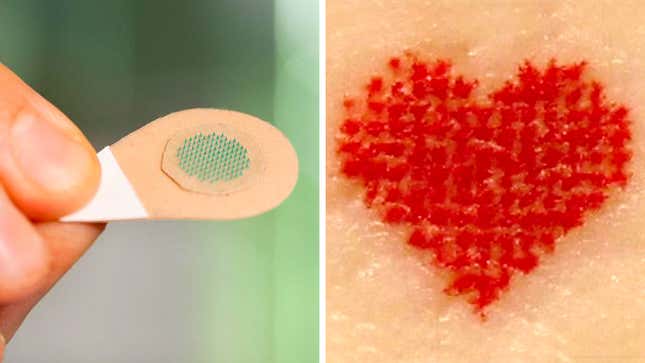
Besides the design you chose, another part of proudly showing off a tattoo is reminding others of all the pain you endured to get it. But that might not always be the case, as researchers from the Georgia Institute of Technology have found a way to borrow a new medical technology to create self-applied tattoos that don’t cause any pain at all.
What gives tattoos their permanence is also what makes getting inked so painful. Tattoo artists use needles to inject tiny drops of ink into the dermis layer of the skin, just below the surface, so that no matter how many layers of skin naturally come off over time, the ink remains safely trapped beneath that self-replenishing outer layer.
Pain is a big part of the experience of getting a tattoo, but not everyone goes through that process by choice. Tattoos are often used as a medical tool, too. For example, cancer patients going through repeated radiation therapy treatments are tattooed with small reference marks allowing the machines, and radiation beams, to be quickly, accurately, and safely targeted each time. Tattoos can also be used to help camouflage post-surgery scars, or provide permanent warnings about serious medical conditions for some patients.
That led a team of researchers from the Georgia Institute of Technology to come up with a way to use microneedle technology as an alternative tattooing technique. As the name implies, microneedles are small enough to inject drugs or medications into the dermis layer of the skin without someone actually feeling them piercing their epidermis, and are often grouped together in large numbers and administered using patches that are simply applied to the skin.

The microneedles created by the Georgia Tech team are smaller than grains of sand and are made from actual tattoo ink that’s contained in a “dissolvable matrix” attached to a flexible patch. Each microneedle essentially works like a pixel of a larger image, and when the patch is applied, pressed into the skin, and left for a few minutes, the ink dissolves and remains in the skin once the patch is removed, leaving a recognizable image behind, but without any of the swelling or bleeding associated with traditional tattooing techniques.
The color of the ink used to create each microneedle can be customized to create full-color tattoo images, just like the pixels on your smartphone’s screen do, and inks that are only visible under ultraviolet light could even be used, as a way to mark patients as needed while keeping any tattooed medical information private.
The research and an accompanying study were recently presented in a paper published in the iScience journal, and it was found that the tattoos could potentially last for up to a year, but also have a shorter lifespan if temporary tattoo inks are used instead. In its current form, the microneedle approach seems like a promising alternative to traditional tattoo techniques when it comes to marking patients, or even livestock (as farmers need to do), but it’s not yet a full replacement for getting inked by a talented artist. The microneedle arrays are relatively small and lack the density to produce high-fidelity imagery. But as the technology is gradually improved, the process of getting a ‘real’ tattoo may one day be no different than that of the temporary tattoos you used to apply as a kid.